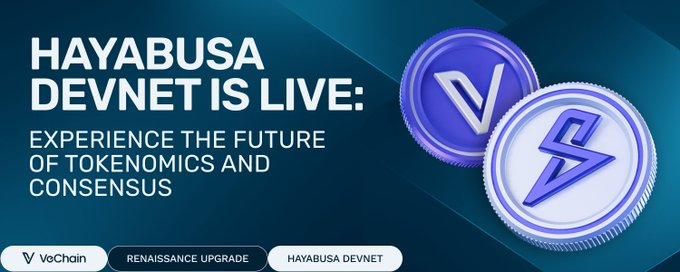
VeChain is using Hayabusa to deliver a dual upgrade of “consensus + economics”: introducing DPoS, directly tying new VTHO issuance to VET staking, and reshaping participation and value distribution through a new incentive model. This Innovation and Tech article focuses on the key changes, timeline, and practical impact on the ecosystem.
Summary: Hayabusa migrates VeChain from PoA to DPoS, implements a new policy that “issues VTHO only to the staked side with a significant cut to overall issuance,” and establishes a validator–delegator mechanism with a new reward curve. The target for mainnet merge is before the end of 2025.
What is VeChain Hayabusa: a dual-track upgrade of “consensus + economics”
Hayabusa is phase two of VeChain’s “Renaissance” roadmap. Its core is switching VeChainThor from PoA to Delegated Proof-of-Stake (DPoS), paired with a full set of token-economic adjustments for VET/VTHO aimed at lowering inflation and directing incentives to participants who truly contribute security and activity. Official plans and explainers note that this upgrade will “intelligently” allocate VTHO and substantially reduce total issuance.
In terms of rollout, the team first launched the Hayabusa Devnet to rehearse parameters and migration, then put the major changes to a stakeholder vote, and will proceed by milestones toward a mainnet merge; both official channels and media have disclosed the vote’s passage and Devnet launch timing.
Why switch to DPoS now?
Historically, VeChain relied on a small set of authority nodes (PoA)—low latency but limited decentralization. DPoS brings VET holders into consensus security as “delegators,” clarifying a “participation → yield” path. Meanwhile, Hayabusa links VTHO “new issuance” to staking scale to avoid the misalignment of “inflating even when usage is low.”
DPoS architecture and how to participate: from VET staking to block production
According to StarGate/VeChain docs, Hayabusa converts the network to DPoS and introduces a two-tier structure of Validators and Delegators: a fixed set of validators produce blocks and secure the network; regular holders can on-chain stake VET and delegate voting power to any validator to earn a share of rewards, dramatically lowering participation thresholds. The docs emphasize that this model is fundamentally different from the previous PoA in both governance and incentives.
The direct effects on VeChain appear in three areas:
- First, election and slashing will align more closely with mainstream PoS practices.
- Second, economic incentives become tied to security: the higher the activity, the stronger the tilt in distribution.
- Third, the professionalization of on-chain roles may foster more infrastructure and custodial staking services, improving the division of labor for nodes and developers.
“VTHO issued only to the staked side”—what it means
After Hayabusa activates, new VTHO is issued only to staked VET (via validators/delegators). Unstaked VET no longer receives the inflation stream. This clearly separates “idle holding” from “security contribution,” suppresses aggregate issuance, and directs yield to the parties bearing security and activity.
VET/VTHO token economics: issuance, distribution, and redesigned “deflationary pressure”
VeChain’s dual-token model is longstanding, but its operating logic changes materially post-Hayabusa: baseline VTHO inflation is reduced and tied to the proportion of staked VET. Combined with gas burning from on-chain usage and dynamic issuance, higher network activity lowers net inflation and can even create stronger deflationary tendencies. Multiple official posts and commentaries describe and illustrate “sharp issuance cuts tied to staking.”
From a holder’s perspective, VeChain’s value capture becomes clearer: as the VET staking rate rises, the VTHO share increases; as application activity burns more VTHO, net supply pressure declines—forming a positive loop of “participation → rewards → falling net inflation.” Industry commentary also describes this combined effect as a “flywheel.”
Details of rewards and governance
The Renaissance materials also mention tools such as Staking NFTs and node tiers to represent different commitment levels and terms; corresponding reward weights and governance power will adjust accordingly. Regardless of expression, the core is to bind “longer-term, steadier staking” to higher weight so rewards tilt to long-term contributors.

Migration cadence and timeline: from voting and Devnet to mainnet
The “all-stakeholder vote” that opened in mid-August quickly reached quorum and passed. Devnet followed, with parameters and integrations entering intensive testing. The public target window for the mainnet merge is before the end of 2025. Roadmaps and industry reports are broadly aligned: vote + Devnet in 2025 Q3, and a full-scale push for mainnet activation and token-economic switch in Q4.
During this process, the VeChain team is publishing updates on VIPs (e.g., 253/254) and parameters via its news site and Medium. Developers can pre-adapt nodes and staking/delegation modules; regular users can watch exchange, wallet, and custodial staking support.
Impact on existing assets and applications
For VET holders, the most direct change is: if you don’t stake, you forgo new-issued VTHO. For app teams, a more dynamic gas economy and fee model may alter cost structures—you’ll need to evaluate VTHO burn/replenishment under different loads. For infrastructure, node roles, parameters, and dashboards will update to meet DPoS security and availability needs.
Implications for the ecosystem and developers: decentralization, incentives, and integration
VeChain’s move from PoA to DPoS essentially “brings token holders into security consensus and allocates yield by contribution.” This yields three knock-on effects:
- More decentralized governance and block production, with stronger community participation and oversight.
- Financialization of staking and delegation, likely spawning more custodial, restaking, and index products.
- For enterprises and developers, a more predictable fees-versus-rewards structure makes deployment/migration economics more straightforward to assess.
Both official channels and BSCN highlight the combined direction of “higher participation, lower inflation, stronger incentives.”
FAQ
How is Hayabusa fundamentally different from the previous PoA?
Previously, a few authority nodes produced blocks; now validators produce blocks and holders delegate votes. Security and yield are directly tied to VET staking.
Why will VTHO issuance be “lower and smarter”?
Issuance is tied to staking; unstaked VET no longer splits new VTHO. With burning, net inflation falls as activity rises.
When will mainnet switch over?
The vote passed and Devnet launched; the publicly stated target for the mainnet merge is before the end of 2025—follow official notices.
What should regular users prepare?
Choose a reputable validator to delegate stake to and watch wallet/exchange support; app teams should track fee and cost-curve changes.
How could this affect VeChain’s long-term value?
If staking and activity reinforce each other, VTHO net supply and governance participation should improve, clarifying long-term value capture.
Key Takeaways
Consensus: VeChain migrates from PoA to DPoS, opening a validator–delegator mechanism that brings holders into the core of security and governance.
Economics: New VTHO is issued only to the staked side; aggregate issuance is cut and linked to staking share; burning adds more deflationary pressure.
Timeline: Vote and Devnet are in place; mainnet merge is targeted before the end of 2025—watch wallet/node/app adaptations.





